 Tip#3: Serve (or bring) some tasty, nutritious options for the big game
Tip#3: Serve (or bring) some tasty, nutritious options for the big gameSuperBowl Doesn’t Have to Mean Supersized Portions
 Tip#3: Serve (or bring) some tasty, nutritious options for the big game
Tip#3: Serve (or bring) some tasty, nutritious options for the big game Tip#3: Serve (or bring) some tasty, nutritious options for the big game
Tip#3: Serve (or bring) some tasty, nutritious options for the big gameSetting the Record Straight on Coconut Oil
 Recently, the wellness community has been up in arms over the presidential advisory released by the American Heart Association (AHA) – it turns out coconut oil may not be the wellness superstar many people thought. The AHA advised that people limit sources of saturated fat, including coconut oil, because it may increase the risk of developing heart disease. However, the funny thing is – the news that sparked headlines and shook up the wellness community wasn’t really news at all.
Recently, the wellness community has been up in arms over the presidential advisory released by the American Heart Association (AHA) – it turns out coconut oil may not be the wellness superstar many people thought. The AHA advised that people limit sources of saturated fat, including coconut oil, because it may increase the risk of developing heart disease. However, the funny thing is – the news that sparked headlines and shook up the wellness community wasn’t really news at all.
Coconut oil is known to be a source of saturated fat. While it has been recommended for a long time to limit sources of saturated fat, the issue isn’t necessarily so clear cut. The AHA recommends limiting saturated fat to 6% or less of one’s daily caloric intake. Typically, it is recommended to consume approximately 30% of one’s calories from fat, meaning over 20% of fat consumed should be in the polyunsaturated and monounsaturated forms (although individual recommendations may vary). While saturated fat isn’t necessarily all bad (it does raise HDL cholesterol – the “good” kind of cholesterol, and we do need some in our diet because it plays an important role in the structural component of cells), it should be consumed in moderation, since it also increases LDL (the “bad” cholesterol) and has been linked to an increased risk of heart disease. Diets rich in monounsaturated fatty acids and polyunsaturated fatty acids are typically referred to as “heart-healthy” due to the cardio protective effect of these fats (for example: the Mediterranean style diet, which emphasizes leafy green vegetables, fruits, nuts, seeds, fish and olive oil).
Coconut oil is touted to be helpful for weight management, digestive woes and everything in between. It’s known for it’s medium chain triglycerides (MCTs), which are digested and absorbed differently than other fats. MCTs are absorbed quickly and bypass the long process typically required to break down and absorb fats, so they may be used clinically for patients who have malabsorption and have even been used as an ergogenic aid for athletes due to it’s perceived quick energy. However, the research that supports the use of MCT oil typically has used an oil that is far more rich in MCTs than traditional coconut oil. While coconut oil contains more MCTs than many other oils, it is not pure MCT oil. Additionally, the link between coconut oil and weight loss is not causative – that is, we do not have any evidence that proves that increasing coconut oil intake causes weight loss. There are many confounding variables that prevent this conclusion from being drawn. It is most likely that people who start using coconut oil and lose weight do so because they are
a) making many other dietary and lifestyle changes, as well
b) feeling satiated from the calories provided by the coconut oil, which can also be provided by other fat and food sources, and possibly limiting their overall caloric intake, which can aid in weight loss.
So, to consume coconut oil or not consume coconut oil – that is the question. Coconut oil is one type of many oils that can be incorporated into an overall healthy diet. In moderation, it can certainly be enjoyed. However, do I recommend loading it up in all of your meals, snacks and coffee? No.
So, unless you plan to lather it all over your body and hair, enjoy it in moderation .
Cauliflower Fried Rice
This “fried rice” takes care of that comfort-food craving, without all of the calories. This veggie-filled dish is topped with eggs and chicken – lean protein sources that are sure to fill you up – and comes in at about 300 calories per serving!

Ingredients (serves 4):
1 1/2 lbs. cauliflower “rice” (you can buy this at many grocery stores, or you can simply cut a large head of cauliflower into small pieces)
1 lb. chicken breast cutlets
1 medium sweet onion (or you can use scallions), chopped
1 yellow squash, chopped
1 zucchini, chopped
2 large cloves garlic, minced
3/4 C carrots, sliced
1/2 C frozen peas, thawed
1 1/2 Tbsp olive oil
1 tsp rice vinegar
3 Tbsp teriyaki sauce ( I like Trader Joe’s Soyaki) – just watch out for sodium and sugar!
Nonstick vegetable oil cooking spray
Dash ground black pepper
1/2 tsp onion powder
1/4 tsp garlic powder
1 large egg plus 1 large egg white, scrambled (raw)
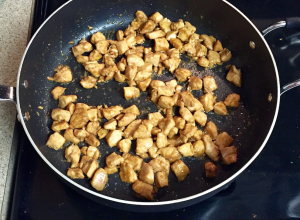 Directions:
Directions:

The Goods: What’s Inside?
Nutritional Analysis Per Serving:
Calories 300 calories, Total Fat 9 g, Saturated Fat 2 g, Cholesterol 112 mg, Carbohydrates 23 g, Fiber 7 g, Protein 35 g, Sodium 431 mg, Calcium 96 mg
Whole Wheat Cous Cous With Chickpeas, Edamame and Peanuts in a Peanut Butter Sauce
This take-out inspired dish is filled with peanut butter-y goodness and offers a fun, different way to enjoy vegetarian protein. Filled with fiber, protein and lower in calories and sodium than traditional take-out, this homemade version will become your new busy night go-to dish!
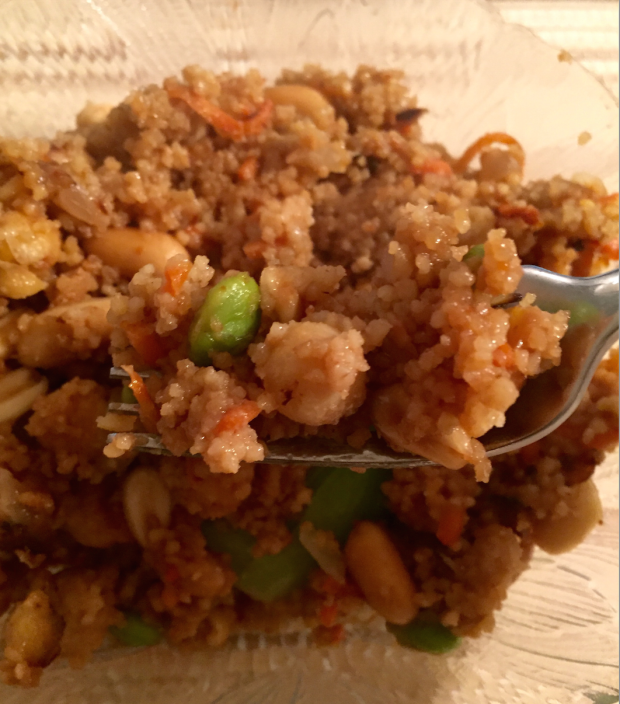
Ingredients (serves 6):
Peanut Butter Teriyaki Sauce:
1/3 C natural, creamy peanut butter
2 Tbsp teriyaki sauce (I like Trader Joe’s Soyaki Sauce)
2 Tbsp rice vinegar
1/4 C water
1/2 tsp hot sauce (I like Cholula or Frank’s Red Hot)
dash crushed red pepper flakes (depends how hot you like it!)
dash ground ginger
*optional: ~1/2 tsp honey to create a sweeter peanut sauce (not included in nutritional analysis)
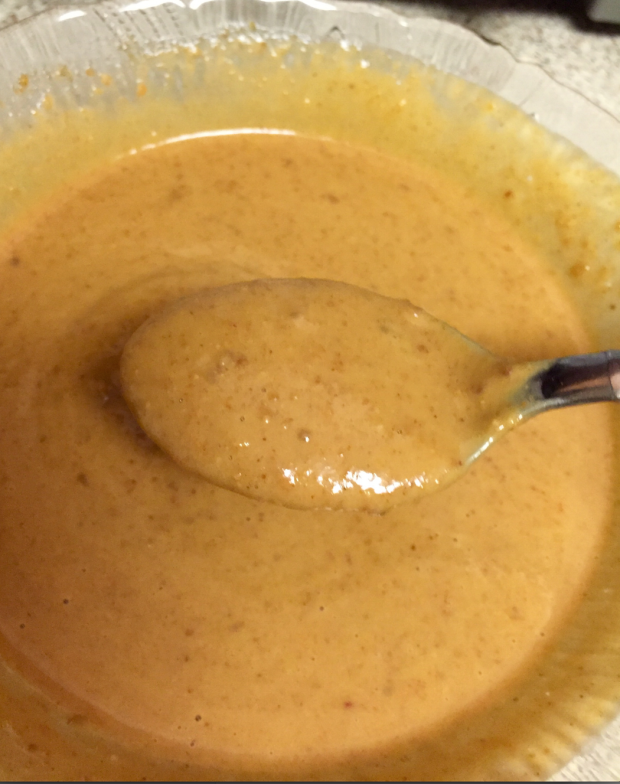
Peanut Sauce!
Stir Fry:
1 C whole wheat cous cous, dry
1/2 large onion, chopped
1 garlic clove, minced
3/4 C carrots, shredded
1 can (15 oz) garbanzo beans (try to find a brand with no added salt – or rinse and strain beans to remove excess salt)
1/4 C edamame, shelled, unsalted and ready-to-eat
5 oz baby bok choy (about 4-5 baby bok choy)
2 Tbsp water
1/4 C peanuts, roasted and unsalted (just the kernels)
*Note: Depending on whether or not you use a nonstick skillet, you may want to add either a nonstick vegetable oil spray or a small amount of olive oil to your skillet in the third step (while you add the spoonful of sauce). If adding olive oil, note that 1 Tbsp olive oil has about 120 calories and 14 grams of fat (this is not accounted for below in the nutritional analysis).
Directions:
The Goods: What’s Inside?
Nutritional Analysis Per Serving
Calories 321 calories, Total Fat 11 g, Saturated Fat 2 g, Cholesterol 0 mg, Carbohydrates 39 g, Fiber 7 g, Protein 14 g, Sodium 438 mg, Calcium 82 mg

Blueberry Banana Smoothie Bowl
This make-ahead breakfast is my favorite for busy mornings. Filled with protein, antioxidants and fiber, this tasty bowl packs in a nutritional punch for few calories (and in no time)! I topped mine with granola, but this smoothie is also delicious on it’s in own in a to-go cup on your way out the door.
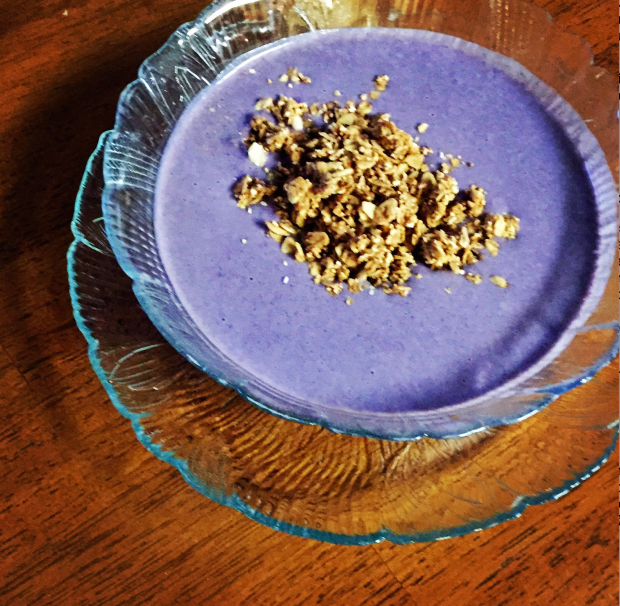
Ingredients (serves 2):
1 ripe banana
3/4 C frozen blueberries
1/4 C natural, creamy peanut butter (I like Smucker’s Natural Creamy Peanut Butter)
1/4 C 0% plain, Greek yogurt
1/2 C milk of your choice
3 ice cubes
Directions:
*Chill in fridge in sealed container if not consuming immediately. I like to make my smoothie at night and just give it a quick stir in the morning – breakfast made easy!
The Goods: What’s Inside?
Nutritional Analysis Per Serving
Calories 332 calories, Total Fat 17 g, Saturated Fat 3 g, Cholesterol 3 mg, Carbohydrates 30 g, Fiber 6 g, Protein 13 g, Sodium 154 mg, Calcium 122 mg
*Note: Nutritional analysis uses 1% (low-fat) milk
Creamy Coleslaw

This coleslaw will have you thinking you’re digging into a mayo-filled bowl of slaw, but I swapped Greek yogurt for the traditional sour cream and mayo to give this bowl of veggies some creamy flavor, without all of the calories. A slaw with some protein and calcium for less than 50 calories per serving? Now you can have your slaw and eat it, too!
Ingredients (yields about ten 1/2-cup servings):
5 C shredded broccoli, carrots, cabbage or any other veggie you love! (I like the Trader Joe’s brand “Shredded Broccoli Slaw” package, which comes with 5 C shredded broccoli stalk and carrots – easy!)
1/4 C roasted sunflower seeds, unsalted
1 C 0% fat, plain Greek yogurt
1/3 C red wine vinegar
1/4 tsp salt
1 Tbsp ground black pepper
1 Tbsp onion powder
2 tsp garlic powder

Now just mix with veggies!
Directions:
The Goods: What’s Inside?
Nutritional Analysis Per Serving (1 serving = about 1/2 cup)
Calories 49 calories, Total Fat 2 g, Saturated Fat 0 g, Cholesterol 0 mg, Carbohydrates 5 g, Fiber 1 g, Protein 4 g, Sodium 84 mg, Calcium 46 mg

I served my coleslaw with a homemade turkey burger!
Chewy Oatmeal Chocolate Chip Cookies
These chewy oatmeal cookies are the perfect holiday cookie – no one would even guess that they are filled with fiber and boast more protein than the average cookie! Using rolled oats, Greek yogurt, dark chocolate and ground cinnamon, these cookies offer wholesome goodness that taste good, too!

Ingredients (yields ~ 20 cookies)
1 1/2 C rolled oats
1 C whole wheat flour
1 1/2 tsp baking powder
1/4 tsp salt
1 1/2 tsp ground cinnamon
1/2 tsp allspice
1 tsp vanilla extract
1/4 C dark brown sugar
1/4 C honey
1 large egg plus 1 large egg white, scrambled
2 Tbsp plain 0% Greek yogurt
1/4 C dark chocolate chips (try to look for at least 72% cocoa)
2 Tbsp 1% (low fat) milk
2 Tbsp water
Nonstick vegetable oil cooking spray
 Directions:
Directions:
*store in an airtight container to preserve freshness
*these cookies are extra amazing when warmed slightly in the microwave – just don’t overdo it!
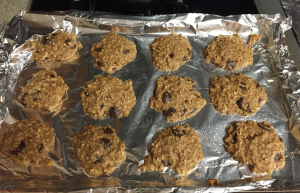
The Goods: What’s Inside?
Nutritional Analysis Per Serving
Calories 136 calories, Total Fat 7 g, Saturated Fat 1 g, Cholesterol 0 mg, Carbohydrates 18 g, Fiber 3 g, Protein 2 g, Sodium 69 mg, Calcium 37 mg
Creamy Cucumber Dill Yogurt Dip
This Tzatziki-style dip is simple to make and offers healthy protein along with a ton of flavor! With 7 grams of protein and less than 50 calories per serving, this dip is the perfect addition to any holiday party – without that heavy holiday food feeling!

Ingredients (serves 6):
1 1/2 C 0% fat, plain Greek yogurt
3/4 C fresh cucumber, diced (make sure to dice into very tiny pieces)
1 1/2 Tbsp dried dill weed
1 Tbsp garlic powder
1/4 tsp ground black pepper
dash salt
Directions:
*Serve with veggies, crackers, pita or use as a topper for grilled chicken, fish, meat or anything!
Note: This dip is best when served immediately, as the cucumbers can make the dip watery if left to sit for too long. If you are making this dip ahead of time, allow the cucumbers to drain on a paper towel in the fridge for a few hours so that they don’t hold as much water. This dip is still great as leftovers, but if entertaining it is best to make just prior to serving.
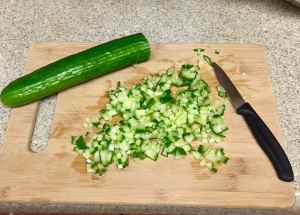
The Goods: What’s Inside?
Nutritional Analysis Per Serving (1 serving is about 1/4 C dip)
Calories 43 calories, Total Fat 0 g, Saturated Fat 0 g, Cholesterol 0 mg, Protein 7 g, Carbohydrates 5 g, Fiber 0 g, Sodium 50 mg, Calcium 85 mg
Pumpkin Pie Made With Whole Wheat Crust
Pumpkin pie is essentially the mascot of the month of November – and this recipe will leave all thankful at your Thanksgiving day table! Loaded with beta carotene (which our bodies can convert to vitamin A), protein and fiber, this hearty dessert actually offers up a slice of nutrition! And for about 200 calories per slice, your belly can be thankful, too!
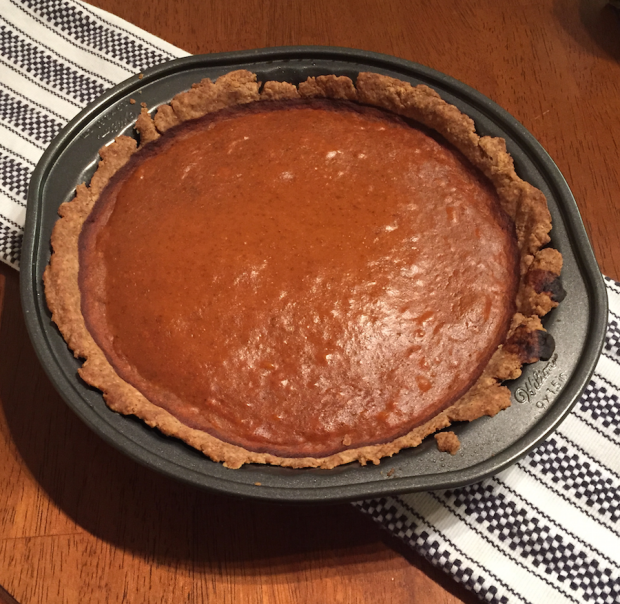
Ingredients (serves 10):
Crust:
Nonstick vegetable oil cooking spray
3/4 C whole wheat flour
1/2 C all purpose flour
1/4 tsp salt
1/4 C canola oil
2 Tbsp 1% milk
3 Tbsp cold water
Pie Filling:
15 oz canned pumpkin puree (about 2 C)
1 large egg
3 large egg whites
1 C dark brown sugar, unpacked
1 Tbsp all purpose flour
1/4 tsp ground ginger
1/8 tsp ground cloves
1 1/4 tsp ground cinnamon
1 tsp ground allspice
1/2 tsp salt
3/4 C 0% plain Greek yogurt
1/4 C 1% milk
1 tsp pure vanilla extract
1 tsp honey
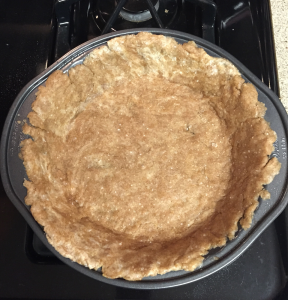
Whole wheat crust!
Directions:
1. Combine all ingredients to make the crust in a large mixing bowl (whole wheat flour, all purpose flour, salt, canola oil, 1% milk and cold water). Mix ingredients together with a spoon to gather, then use your hands to knead the dough so that all ingredients are well combined.
2. Spray a 9″ diameter pie pan with nonstick vegetable oil cooking spray. Transfer dough ball to center of pie pan and use your hands to spread the dough evenly, bringing the dough up over the sides and edges of the pan. Preheat oven to 350 degrees Fahrenheit.
3. In a small bowl, whisk together egg and egg whites. In a large bowl, whisk together pumpkin, brown sugar and eggs from smaller bowl. Make sure to smooth any clumps of brown sugar. Add flour, spices, Greek yogurt, milk, honey and vanilla extract to pumpkin mixture and whisk together until well combined.
4. Set aside the batter to thicken. In the meantime, bake the pie crust in the oven for about 5-7 minutes, until slightly browned. Remove from oven.
5. Fill the pie crust with the pie filling so that the pan is about 3/4 full. There may be extra filling depending on the depth of your pan (you can repurpose this for other treats or mini pies if you’d like!) and bake in the oven at 350 degrees Fahrenheit for 1 hour, or until slightly browned. You can check for doneness using a toothpick (make sure that the toothpick comes out clean when dipped into the center of the pie).
6. Chill pie in the fridge until cold and set – about 4 hours minimum. It may help to store it covered with aluminum foil or parchment paper to prevent the pie from absorbing odors from the fridge. After you serve the pie, store in the fridge, covered for up to 3-5 days, or freeze in an airtight container or bag. Enjoy!
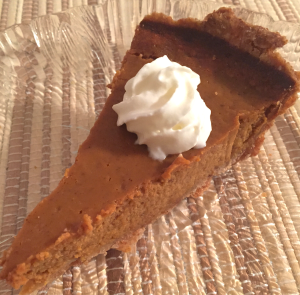
Yum!
The Goods: What’s Inside?
Nutritional Analysis Per Serving (1 serving is one slice that is 1/10th of the pie)
Calories 208 calories, Total Fat 6 g, Saturated Fat 1 g, Cholesterol 19 mg, Carbohydrates 32 g, Fiber 3 g, Protein 6 g, Sodium 217 mg, Calcium 66 mg
Sautéed Scallops
This dish is packed with lean protein and skimps on a heavy sauce that is traditionally served with scallops. Instead, olive oil, spices and a small amount of butter (or in this case, Smart Balance made with olive oil) create a light coating and add a ton of flavor. I served my scallops over my whole wheat orzo salad (and made enough for leftovers)!
Ingredients (serves 2):
12 oz scallops, raw
1 Tbsp olive oil
1/4 tsp ground black pepper
1/4 tsp garlic powder
dash salt
1/8 tsp cayenne pepper
1/2 tsp butter (I prefer Smart Balance made with olive oil)
Nonstick vegetable oil cooking spray
Directions:
The Goods: What’s Inside?
Nutritional Analysis Per Serving:
Calories 216 calories, Total Fat 9 g, Saturated Fat 1 g, Cholesterol 56 mg, Carbohydrates 4 g, Fiber 0 g, Protein 29 g, Sodium 279 mg, Calcium 41 mg
because health isn't funny